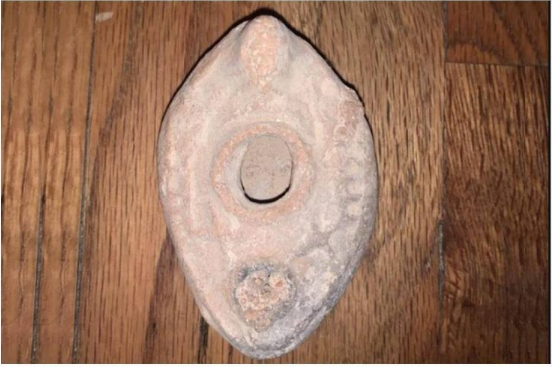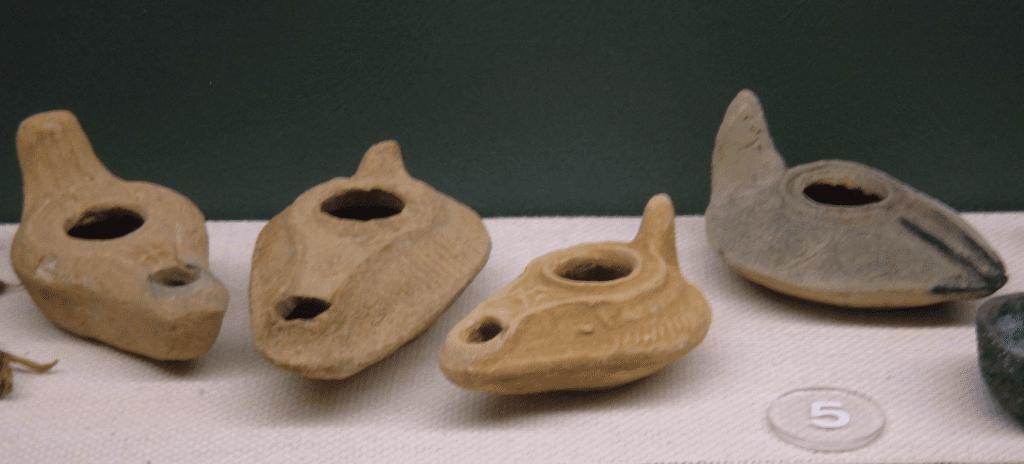The Ancient Oil Lamp: A Timeless Source of Light
At first glance, it may look like nothing more than a weathered stone. But hidden in its design is one of humanity’s oldest tools for survival and daily life: the oil lamp. Long before electricity illuminated cities, these small objects brought light into homes, temples, and streets. With its carved center and raised spout, this ancient artifact tells a story of ingenuity, practicality, and culture that spans thousands of years.

What Is an Ancient Oil Lamp?
An oil lamp is a simple yet ingenious device designed to hold fuel—most often olive oil in the Mediterranean world—that feeds a small flame through a wick. The lamp pictured here shows the typical features: a wide central hole for pouring oil and a narrow spout with a smaller hole for placing the wick. When lit, the wick would draw the oil upward, creating a steady flame that could burn for hours. For ancient families, this was not just convenient—it was essential.
Origins and Historical Use
Oil lamps have been used for millennia, stretching back to the Bronze Age. Their presence spans many ancient cultures, from Greece and Rome to Egypt and the Middle East. In these societies, lamps lit homes, marketplaces, and places of worship. They weren’t only about visibility after sunset; they carried symbolic value as well. In many traditions, light represented life, knowledge, and spirituality. Imagine living in a small stone house two thousand years ago—the glow of a lamp like this would have been your only light after dark.
Video : Biblical Style Clay Oil Lamp
Design and Craftsmanship
Though simple in concept, oil lamps often displayed remarkable artistry. Early versions were carved from stone or molded from clay. Over time, decorative patterns, inscriptions, and even religious symbols were added. The raised bump or spout wasn’t just functional—it often carried stylistic elements that identified the maker, the region, or even the household’s social status. Some lamps were plain and practical, while others were intricate works of art worthy of wealthy homes or temples.
The Role of Olive Oil
One of the most fascinating aspects of oil lamps is their connection to olive oil. In ancient Mediterranean societies, olive oil was a cornerstone of life. It was used in cooking, medicine, rituals, and—most importantly—lighting. The availability of olive oil made lamps practical, reliable, and relatively inexpensive for everyday use. Even today, the phrase “to keep the lamp burning” traces its roots back to this practice of using oil as a steady source of light.

Cultural and Symbolic Importance
Beyond practicality, lamps held deep cultural significance. In ancient Rome, lamps were lit during festivals and religious ceremonies. In Jewish tradition, the eternal flame (ner tamid) is inspired by the continual burning of lamps in temples. Early Christian art often depicted lamps as symbols of hope, guidance, and divine presence. The act of lighting a lamp was never just functional—it carried a sense of ritual, marking moments of reflection, prayer, or community gathering.
From Antiquity to Archaeology
Today, oil lamps like this one are prized by archaeologists. They help scholars understand daily life, trade routes, and cultural values of ancient civilizations. The style of a lamp can reveal where it was made, who might have used it, and what historical era it belonged to. In a way, each lamp is like a time capsule, holding the memory of households long gone but never forgotten.
Video : A Roman terracotta oil lamp, circa 1st – 4th century AD
Why These Lamps Still Fascinate Us
Why are we still drawn to these simple tools? Perhaps because they remind us of human resilience and creativity. The oil lamp was a solution to a basic need, but it became a symbol of something much bigger—hope, warmth, and continuity. Even in a world now powered by electricity and digital screens, there’s something mesmerizing about the soft flicker of a flame. It connects us to our ancestors in the most human way possible.
Conclusion: A Flame That Never Died
The object in the photo may seem like a rough, ancient stone, but in truth, it’s a window into a world that depended on ingenuity for survival. The ancient oil lamp lit homes, guided prayers, and symbolized life itself across countless cultures for thousands of years. Its design—simple, practical, yet beautiful—remains a testament to the creativity of our ancestors. Long before light bulbs, these little lamps carried humanity through the dark, one flickering flame at a time.